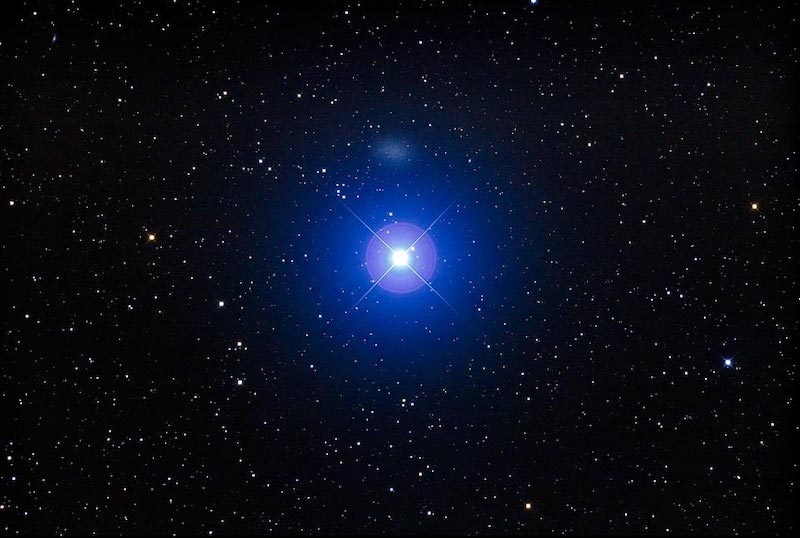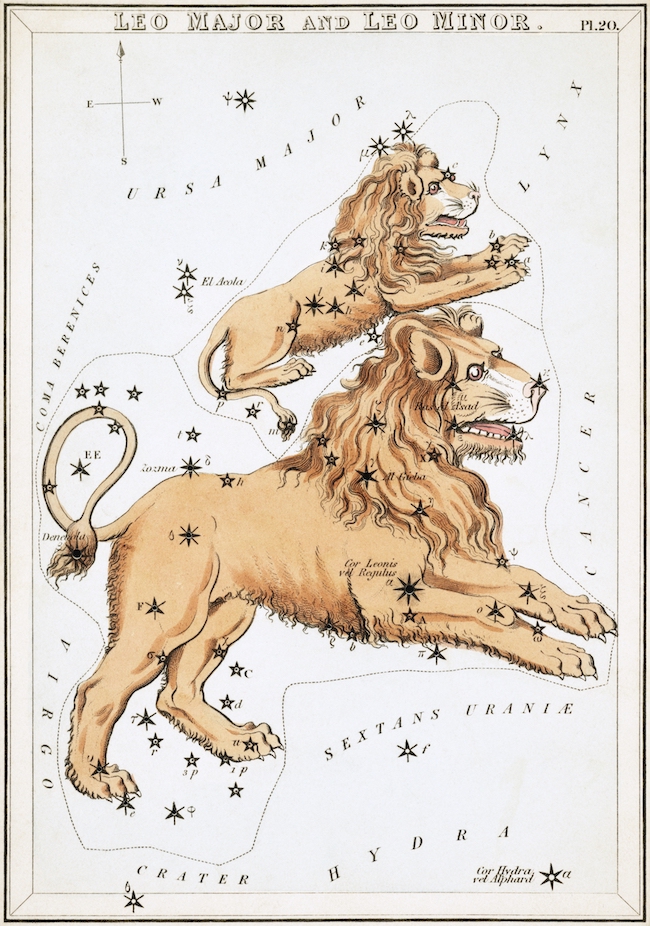
Regulus, the brightest star in the constellation Leo the Lion, is a harbinger of spring in the Northern Hemisphere. It crept higher in the sky with each passing day in March and April, as winter favorites like Orion the Hunter descended westward. And now, in May, this blue-white star is brilliant in the eastern evening sky as soon as the sun goes down.
You can locate Regulus – also known as Alpha Leonis – at the base of a star pattern that appears like a backward question mark. This pattern, known as the Sickle, makes up the head and forequarters of Leo the Lion.
Regulus is also one of three bright stars to make up the asterism known as the Spring Triangle.
Regulus ranks 21st in the list of brightest stars in our sky. However, although it looks like one star to the eye, it’s actually four stars.

Regulus is visible most of the year
Around February 18, Regulus was opposite the sun. It rose above the horizon as the sun set, stayed up all night long, and reached its highest point due south (as seen from the Northern Hemisphere) at local midnight. By early April, Regulus was well up in the southeast an hour after sunset. By early June, it’ll be high in the southwest an hour after sunset. In early July, Regulus will be low to the west an hour after sunset. And from mid-September through mid-February, Regulus will be in the morning sky.
So, Regulus is visible at some time of night throughout the year, except for about a month on either side of August 22. If you looked toward Regulus around that date, you’d see the sun.
Planets and the moon pass near it
Regulus is the only 1st magnitude star to sit almost squarely on the ecliptic, which marks the path of the sun, moon and planets across our sky.
So bright planets sometimes pass near Regulus. For example, in early-August 2024, Venus will visit Regulus in the evening sky. And in early-September, 2024, Mercury will join Regulus in the morning twilight. Also, planets can sometimes occult – or pass in front of – Regulus. The last planet to occult Regulus was Venus on July 7, 1959. Then on October 1, 2044, Venus will occult Regulus again.
And, every month, the moon passes near Regulus. In some years, the moon occults this star as seen from Earth. There will be a series of 20 lunar occultations of Regulus from July 2025 to December 2026. During the December 2026 occultation, Mars and Jupiter will be nearby.
A blue, egg-shaped star
Regulus is located about 79 light-years from Earth. It’s a multiple system with at least four component stars. The main star – Regulus A – is large and blue with a spectral type of B8 IVn. Its surface temperature averages about 12,460 kelvin (21,970 degrees F or 12,190 degrees C), which is much higher than our sun’s surface temperature. Regulus A is 3.8 times the mass of our sun, about 4 times as wide, and almost 300 times as bright.
Regulus spins on its axis once every 16 hours. In contrast, our sun spins on its axis about once every 27 days. This fast rotation causes Regulus A to bulge at its equator, so it appears oblate, or egg-shaped. In fact, if Regulus rotated just a bit faster, it would fly apart! And Regulus is not the only star with a fast spin. The stars Altair and Achernar are also fast spinners with flattened, oblate shapes.

Regulus is 4 stars
Look through a small telescope using at least 50x magnification, and you can see Regulus as two objects separated by 177 arcseconds. The brighter of the pair is called Regulus A.
The fainter one is Regulus B, a cool “orange” dwarf star with a spectral classification of K2 V. The B star has a mass that is 80% of the sun’s, and it’s half as bright. It has a surface temperature of 4,885 kelvin (8,300 F or 4,600 C), and it shines at magnitude 8.1.
Regulus B, meanwhile, has its own companion: Regulus C. At magnitude 13.5, it’s only visible with powerful telescopes. With just 1/3 the mass of the sun, Regulus C is a red dwarf star with a spectral classification of M4 V. Regulus B and C are gravitationally bound to each other, and together they’re called Regulus BC. The distances between B and C ranged from 4.0 to 2.5 arc seconds between 1867 and 1943. There are no recently available measurements.
The fourth star in the system has never been directly resolved via imaging, but its presence is revealed by spectroscopic analysis of Regulus A. Astronomers think it may be a closely orbiting white dwarf star.
You might have heard of a star called Regulus D. This does not refer to the spectroscopic companion of Regulus A, but to a 12th-magnitude star that sits 212 arcseconds from Regulus. For decades, people believed it to be a companion of Regulus, but recent studies from the Gaia satellite show this to be a background star not related to the Regulus system.
A galaxy photobombs Regulus
Situated 1/3 degree north of Regulus is the galaxy Leo I, you can see it as a faint patch of light in the photo below. Leo I is difficult to see due to its proximity to Regulus. Albert George Wilson found it on photographic plates taken as part of the National Geographic Society-Palomar Observatory Sky Survey in 1950. It would be another 40 years before anyone viewed it.
Leo I is a dwarf galaxy, and a member of our local group. Amateur astronomers can view it, but this requires dark skies and a large telescope.

A rex by any other name
The name Regulus is from the diminutive form of the Latin rex, meaning little king.
Ancient Arab stargazers called Regulus by the name Qalb al-Asad, which means Heart of the Lion. It also bears the nickname Cor Leonis, again meaning Lion’s Heart. Fittingly, King Richard I of England was also famously known as the Lionheart, or more commonly Coeur de Lion in French.
There is a great deal of mythology associated with Leo, perhaps the most common tale being that Leo was the Nemean Lion of the Hercules story. Some Peruvians also knew these stars as the Mountain Lion, whereas in China it was sometimes seen as a horse, and at other times as part of a dragon. Christians in the Middle Ages sometimes referred to it as one of Daniel’s lions.

Bottom line: Regulus, the brightest star in the constellation Leo the Lion, is associated with the arrival of spring and is prominent in May skies. It looks like a single point of light, but is really four stars.











